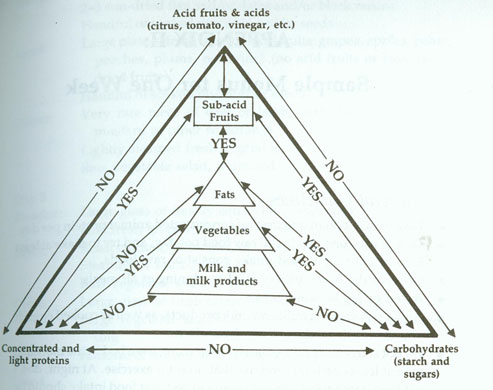Food Categories in Food Combining Chart I. Proteins: foods that contain 15 per cent or more protein matter Concentrated proteins: meat, fish, fowl, eggs, milk, cheese Light proteins: nuts, beans, peas, soy beans products, avocados whole grains II. Carbohydrates: foods that contain 20 per cent or more starch and/or sugars Starch: peanuts, bananas, potatoes, all pasta product,rice breads, cakes, pies, refined cereals, etc. Sugars: whole, brown and raw cane sugar, fructose, honey, maple syrup, dried sweet fruits (dates, raisins, figs, prunes) III. Fats: animal or vegetable oils Animal: butter, cream, lard, tallow, fatty meats Vegetable: Olive, soy bean, sunflower seed, sesame, safflower corn, and all nut oils IV. Vegetables: lettuce, celery, cabbage, broccoli, spinach, bean sprouts, cucumber, asparagus, onion, eggplant, turnip,water- cress, leek, zuccini, string bean, green pepper, radish,carrot, okra, artichoke, olive, etc. Exceptions: potatoes act as a starch; tomatoes act as an acid fruit V. Fruits Acid fruits: orange, grapefruit, lime, lemon, berries, cranberry pineapple, tomato Sub-acid fruits: apple, pear/ peach, cherry, grape, apricot, nec- tarine, plum, etc. Melons: watermelon, musk melon, honey dew melon, cantaloupe, papaya, etc. Exceptions: bananas act as a starch; dried figs, dates, raisns and prunes act as sugars

Notes: 1. 'No' denotes incompatible combinations. 2. 'Yes' denotes compatible combinations. 3. Milk is best taken completely alone as a protein food, preferably as raw certified milk. 4. Melons are not included in the 'fruit' headings above; they should always be eaten alone for optimum digestion and assimilation. 5. Bananas, figs, dates, prunes and raisins are sugar/starch foods of the very best quality, and should not be mixed with proteins. 6. Vegetables combine well with everything, except for potatoes (a starch) and tomatoes (an acid). 7. Fats should be avoided with concentrated proteins, but are relatively compatible with light proteins. 8. The closer to the fresh, raw state a food is consumed, the more com- patible it is with other varieties of food; therefore, try to make at least 50% of your diet consist of fresh, raw foods consumed in the fresh, raw state. That will provide the active enzymes and moist, raw fiber required to compensate for incompatible combinations of cooked foods.